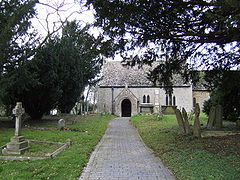Eaton Hastings
| Eaton Hastings | |
|---|---|
 St. Michael & All Angels parish church |
|
| Eaton Hastings shown within Oxfordshire | |
| Population | 81 (2001 census) |
| OS grid reference | SU260982 |
| Civil parish |
|
| District | |
| Shire county | |
| Region | |
| Country | England |
| Sovereign state | United Kingdom |
| Post town | Faringdon |
| Postcode district | SN7 |
| Dialling code | 01367 |
| Police | Thames Valley |
| Fire | Oxfordshire |
| Ambulance | South Central |
| EU Parliament | South East England |
| UK Parliament | |
Eaton Hastings is a village and civil parish beside the River Thames about 2.5 miles (4.0 km) northwest of Faringdon. It was part of Berkshire until the 1974 boundary changes transferred it to Oxfordshire. Eaton Hastings was formerly considerably larger than it is today, and is regarded as a deserted medieval village.
The original village developed around the parish church. Today all that remains are a few scattered dwellings and the church. The population started to decline after 1349, until by the 19th century it consisted only of a few scattered farmhouses. The depopulation has been attributed to bubonic plague, emparking and sheep farming. Late in the 19th century a group of houses was built on the Lechlade to Faringdon road, designed by the architect Ernest George for Alexander Henderson, 1st Baron Faringdon as part of a social improvement project. Many people now regard this as being Eaton Hastings, but the remaining buildings of the original settlement are down a single lane road and not visible from the main road.
The Church of England parish church of Saint Michael and All Angels is the most prominent surviving building of the original settlement. The earliest parts of the church date from the 11th century. It is constructed of rubblestone and consists of a simple nave, chancel and bellcote. The chancel largely dates from the 13th century. Between 1870-73 the church underwent Victorian restoration.
...
Wikipedia

